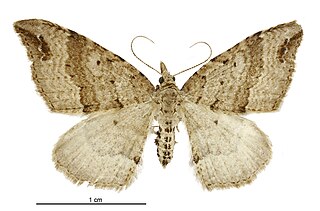Laelapia is a monotypic moth genus in the family Erebidae. Its single species, Laelapia notata, is found in Madagascar. Both the genus and species were first described by Arthur Gardiner Butler in 1879.
Callicereon is a monotypic moth genus of the family Noctuidae erected by Arthur Gardiner Butler in 1882. Its only species, Callicereon heterochroa, was first described by Paul Mabille in 1879. It is found on Madagascar.

Phaiogramma is a genus of moths in the family Geometridae erected by Carl Freiherr von Gumppenberg in 1887. Markku Savela gives this name as a synonym of ChlorissaStephens, 1831.
Detoulgoetia is a genus of tiger moths in the family Erebidae. The genus was erected by Vladimir Viktorovitch Dubatolov in 2006. The moths are found in Madagascar and Comores. David T. Goodger and Allan Watson (1995) note that the species of this genus have white or yellowish wings speckled with brown dots without order and with dark discal spots.
Lamprosema guttalis is a species of moth of the family Crambidae described by Pierre Viette in 1958. It can be found in Madagascar.
Scopula roezaria is a moth of the family Geometridae first described by Charles Swinhoe in 1904. It is found on Madagascar.
Mpanjaka grandidieri is a moth of the family Erebidae first described by Arthur Gardiner Butler in 1882. It is found in central Madagascar.
Mpanjaka elegans is a moth of the family Erebidae first described by Arthur Gardiner Butler in 1882. It is found in central Madagascar.
Labordea prasina is a moth of the family Erebidae first described by Arthur Gardiner Butler in 1882. It is found in central Madagascar.
Mpanjaka pastor is a moth of the family Erebidae first described by Arthur Gardiner Butler in 1882. It is found in central Madagascar.
Cyana saalmuelleri is a moth of the family Erebidae first described by Arthur Gardiner Butler in 1882. It is found on Madagascar.

Galtara extensa is a moth of the subfamily Arctiinae first described by Arthur Gardiner Butler in 1880. It is found on the Comoros and in Madagascar.
Crocinis is a genus of moths from Madagascar belonging to the subfamily Drepaninae. The genus was erected by Arthur Gardiner Butler in 1879.
Spilosoma hercules is a moth in the family Erebidae. It was described by Hervé de Toulgoët in 1956. It is found on Madagascar.
Gracilanja is a monotypic moth genus in the family Eupterotidae erected by Thierry Bouyer in 2011. Its single species, Gracilanja gracilis, was described by Francis Walker in 1855. It is found in Cameroon, the Republic of the Congo, the Democratic Republic of the Congo, Equatorial Guinea, Ghana, Sierra Leone and Uganda.
Phiala cunina is a moth in the family Eupterotidae. It was described by Pieter Cramer in 1780. It is found in Cameroon, Nigeria and Sierra Leone.

Asaphodes beata is a species of moth in the family Geometridae. It is endemic to New Zealand and is a relatively common species that can be found throughout the country in native forest or scrub habitat. It can be distinguished from its close relative Asaphodes adonis by the colour of its hind wings. The larvae of this species feeds on watercress but tends to be inactive during the day. If threatened it will mimic a twig dropping to the ground. The adult moths are on the wing from October to March and are said to be attracted to white rātā. The white markings on the forewing of the adults are variable in appearance.

Samana acutata is a species of moth in the family Geometridae This species is endemic to New Zealand. It is classified as "At Risk, Relict" by the Department of Conservation.

Homodotis falcata is a moth of the family Geometridae. It is endemic to New Zealand and is found in the southern part of the South Island. The larvae of this species feed on leaf litter and adults are on the wing for most months of the year. The forewings of this species can vary in depth of colour.

Atomotricha sordida is a moth in the family Oecophoridae first described by Arthur Gardiner Butler in 1877. It is endemic to New Zealand and has been observed in the South Island in the Canterbury and Otago regions. The adult female of the species is brachypterous.






